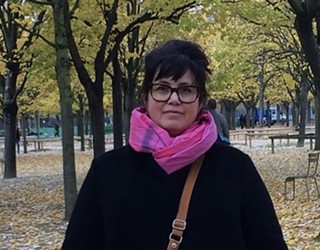Last year Glen Gentele, Orlando Museum of Art's director, inaugurated the Florida Prize in Contemporary art. It's a simple scheme: three or four judges look at 10 selected regional artists, and the best wins a cash prize. Sounds easy, but comparing paintings to videos to neon lights to napalm ... not so easy. This year, Miami painter Farley Aguilar won the $20,000 prize for his vivid, intense portraits, adding to his rise as Miami's current art star. Orlando Weekly's Jessica Bryce Young and Richard T. Reep parley about what the show is all about this year.
RTR: Aguilar's a new hero to me, because he is rising despite lacking that so-precious MFA credential after his name. He takes 19th-century portraits, like this classic unsmiling family standing stiffly in front of their shack, and he spoofs them. It's as if each person's inner creepazoid gets revealed – killer zombie eyes, shiny yellow boots and all. It got under my skin.
JBY: His work is haunting, isn't it? The massive paintings put you face-to-face with these life-sized monsters (somehow made more creepy by their vivid colors, like darkness Disneyfied), but the smaller ink-on-paper works are mesmerizing, too; you have to peer so closely, it feels like they might suck you right into the frame. Aguilar's artist statement refers to his "anxiety and dread," and his mistrust of social organizations that "vilify the non-conformist." His troweled-on impasto is carved here and there with tiny words and messages. You can almost hear him muttering to himself over the palette knife.
RTR: They draw you in, and you are rewarded. This year the focus is on the human factor. I was left with a sense of great connectedness with other souls in this show, something I did not come away with last year. At the same time, I feel it's a little more uneven, with some great stuff and some things I wish were great.
JBY: So what's great, and what's not so great?
RTR: Cesar Cornejo's "Puno MoCA" seems hastily built. One has to dodge, at eye level, sheet metal and the raw splintery edge of lauan held together with drywall screws, something one shouldn't have to encounter in an exhibit. Even so, as a reference to mini-museums Peruvians display in their homes, it works as a concept piece and I love that.
On the other hand, Rob Duarte's "One Dies, Get Another" is gorgeously detailed, ironic because visually it is a quiet installation but it has a very loud message about social justice, and of course that incessant tapping. Further, his "Lost #2" is obsessively meticulous, a pin map onto which he projects deliberately fuzzed videos of drone strikes. I found that compelling, achingly sad for our times, and it set me up for the rest of the show. And a Maya Lin "Pin River" reference, to boot.
JBY: (OK, I admit it: I had to look up "lauan.") The problem with Cornejo's work is the problem with a lot of social practice art: The actual work is not the thing we are seeing. His experience of gaining the trust of and serving these families, honoring and elevating their traditions, is difficult to feel while looking at these documentary relics of the project. The real work is out there in the world, intangible.
And Duarte's conceptual installation contending with Florida's history of using prison slave labor evoked a reaction in me similar to your disappointment with "Puno MoCA": I got it, but I didn't feel it. Not until it was explained in the artist's statement, anyway.
RTR: Duarte's work gestures toward compassion, but you're right, it is cerebral. Wanda Raimundi-Ortiz, on the other hand, is much more than a gesture; it's a full-bodied exploration of Latina identity. She inkwashed a 12-foot portrait and poem right on the wall, a graffiti tag. Her red wall portrait is more somber, hinting at her darker side. She uses herself as the vehicle for art, but we are left with a mystery of who she really is.
JBY: Yes – she's a UCF professor, and she's YouTube famous, but she plays with identities. Her video in which she plays all the roles of a telenovela, her "Chuleta" and "Garbage Queen" characters – all are hilarious, but don't overlook the soulfulness of this work, or the melancholy of her enormous murals.
I fell in love with Alex Trimino's yarn-and-neon forest at the top of the show: the melding of hard technology with organic handmades, the playful slap at the gendering of materials – "textiles are for girls, electronics are for boys." These neo-primitive totems reminded me of Sarah Sze's work, always a good thing. And in fact, knitted tubes and neon tubes aren't diametrically opposed; mathematical principles are as present in knitting as in LED light controllers.
RTR: Yes, there's more than a hint of sexuality in these. Knitting is actually a precise geometric exercise, while light softly molds itself to the surface it hits. However, in Trimino's coverings, the hardness of the light tubes wasn't mediated, and for me was harsh against the soft yarn and textiles, or perhaps the lights were too bright. I was frankly more entranced with the coverings, which evoked a sense of caring.
JBY: You can't mention caring without bringing up Antonia Wright's videos. Her "Are You OK?" performance, a series of videos in which she stands in various public places crying until a stranger responds, are wrenching. And "Suddenly We Jumped (Breaking the Glass Ceiling)" may strike some as a heavy-handed reference/reaction to misogyny. But there's no denying the utterly stunning boldness of throwing yourself through a sheet of glass. She really did it, using a trampoline; no special effects. (And the video is transfixingly beautiful.)
RTR: Yes, Wright's videos masterfully build tension, and her message lingers strongly. The deepest emotional connection I found was with Jennifer Kaczmarek's very intimate, large-scale portraits. Her colorful series Love for Alyssa is moving. Her subjects are given a dignity and perception, not judgement, that is so startling because it is so rare.
In the same room, uncomfortably close, was Michael Covello's installation "The Forest Ravenous" (our cover image). More breathing room is needed between this and Kaczmarek's photographs. Covello (trained originally as an architect) cascaded a rainbow chaos of sharp-edged fragments of stuff down behind two floating, black velvety squares. Covello first showed in our area at the Maitland Art Center earlier this year, and with this large wall he's really gone at it. It feels like movement, while his paper and painted collages are more ordered.
JBY: Covello's Maitland installation, "Hound on the Moor," was claustrophobic, enveloping; it filled all six surfaces of a small, low-ceilinged room (with a soundtrack on headphones to complete the closing-off). This piece turns that one inside out – it's bright and airy, with plenty of white space and motion, and, I thought, humor. And those candy-colored torn-paper collages filled me with an acquisitive glee; I really wanted to take one home.
RTR: The last room is both a high and a low. Bhakti Baxter's "Circle Spiral for OMA" is a monumental, dramatic piece in the great tradition of op art. I love it. And Baxter's pure cement cubes are very architectural, very beautiful. I found them to resonate in a quiet way.
Nicolas Lobo's carbon-fiber fabric pieces and his styrofoam stones are groundbreaking, using unusual materials to make art. The stones are made of styrofoam melted by gasoline, then covered with Play-Doh. In Orlando, you know, you see so much faux rockwork that you become very jaded about it; these have a science-fiction quality but do not quite fit next to Baxter's real cement.
JBY: I feel you on the high/low thing; I wanted to love Baxter's algorithmic mindfuck (it's not actually a spiral, but simply a series of offset concentric circles) and his concrete hypercube and column, but while I was fascinated by the thought process that went into them, the process was more interesting than the product. As far as Lobo's work, I thought his stretched fiber surfaces and curvy, coralline styrofoam schmoos were very sensual. And of course, plastic plus gasoline equals napalm, right? And the fiber work was shredded T-shirts over Kevlar. So it's more than a little funny that this work was hanging in the Lockheed Martin Gallery.
RTR: No irony there, eh? Play-Doh among war machines. The judges had a difficult task this year, which is a very good thing. Visually compelling work that makes you think AND feel.
JBY: Poetic, political and deeply personal. Viewers have until Sunday, Sept. 6, to visit (or revisit), then it's all over until next year.


















